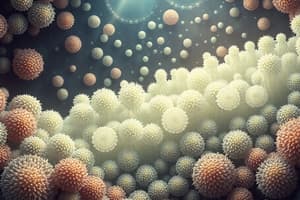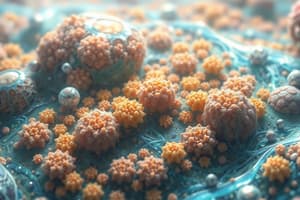Podcast
Questions and Answers
What does the Most Probable Number (MPN) method estimate?
What does the Most Probable Number (MPN) method estimate?
- The total turbidity of a liquid sample
- The size of bacterial colonies on a plate
- The number of viable microorganisms in a sample (correct)
- The average generation time of microorganisms
Which of the following best describes coliform bacteria?
Which of the following best describes coliform bacteria?
- Bacteria that indicate water is safe for drinking
- Non-pathogenic bacteria exclusively found in soil
- Lactose-fermenting bacteria that signal potential water contamination (correct)
- Bacteria that do not ferment lactose
In the MPN method, how many tubes showed growth in the 1-mL dilution?
In the MPN method, how many tubes showed growth in the 1-mL dilution?
- No tubes showed growth
- All tubes showed growth
- 2 out of 5 tubes showed growth (correct)
- 1 out of 5 tubes showed growth
What is the purpose of the pH indicator in lactose broth during the MPN method?
What is the purpose of the pH indicator in lactose broth during the MPN method?
What does a high turbidity in a liquid bacterial culture indicate?
What does a high turbidity in a liquid bacterial culture indicate?
Which dilutions in the MPN method showed positive growth results?
Which dilutions in the MPN method showed positive growth results?
Which environmental factor can influence microbial growth in the MPN method?
Which environmental factor can influence microbial growth in the MPN method?
What term describes the time it takes for cells to divide?
What term describes the time it takes for cells to divide?
How is the estimated number of bacteria derived from the MPN results?
How is the estimated number of bacteria derived from the MPN results?
During which phase do cells become less sensitive to antibiotics?
During which phase do cells become less sensitive to antibiotics?
Which factor primarily causes the growth to slow in the stationary phase?
Which factor primarily causes the growth to slow in the stationary phase?
What is the main purpose of using a chemostat in microbial growth?
What is the main purpose of using a chemostat in microbial growth?
Which staining method differentiates between live and dead cells?
Which staining method differentiates between live and dead cells?
What does the direct microscopic cell count method use for counting cells?
What does the direct microscopic cell count method use for counting cells?
Which type of cells may survive during the death phase and potentially cause chronic infections?
Which type of cells may survive during the death phase and potentially cause chronic infections?
In what condition is the intrinsic growth rate predominantly measured?
In what condition is the intrinsic growth rate predominantly measured?
What role does the extracellular polymeric substance (EPS) play in a biofilm's structure?
What role does the extracellular polymeric substance (EPS) play in a biofilm's structure?
During the initial stages of biofilm formation, what characterizes the attachment of planktonic cells?
During the initial stages of biofilm formation, what characterizes the attachment of planktonic cells?
How do microorganisms within a biofilm collaborate metabolically?
How do microorganisms within a biofilm collaborate metabolically?
What mechanism allows bacteria in biofilms to sense their population density?
What mechanism allows bacteria in biofilms to sense their population density?
What is a significant effect of biofilms on human health?
What is a significant effect of biofilms on human health?
What is a common resistance mechanism found in pathogens within biofilms?
What is a common resistance mechanism found in pathogens within biofilms?
Which structures facilitate the interaction of cells with the extracellular polymeric substances (EPS) in mature biofilms?
Which structures facilitate the interaction of cells with the extracellular polymeric substances (EPS) in mature biofilms?
What is a potential drawback of biofilms in medical devices?
What is a potential drawback of biofilms in medical devices?
Flashcards are hidden until you start studying
Study Notes
Biofilms Overview
- Biofilms in slow-moving water exhibit a mushroom-like shape and contain clusters of microorganisms.
- Extracellular polymeric substances (EPS) comprise 50%-90% of biofilm mass, primarily made of polysaccharides, proteins, nucleic acids, and lipids.
- EPS maintains biofilm structure, ensures hydration, and protects microorganisms from predation.
Biofilm Formation
- Planktonic cells attach to surfaces and transition to sessile cells.
- Initial attachment is reversible, but cells soon produce EPS, solidifying the connection.
- Water channels develop within the biofilm matrix, facilitating nutrient and waste exchange.
- Structures such as fimbriae, pili, and flagella are pivotal in forming mature biofilms.
- Cells can later revert to planktonic states, spreading to colonize new areas.
Biofilm Dynamics
- Inter-microorganism collaboration allows for mutual benefit; waste from one can feed another.
- Aerobic organisms generate anaerobic zones, supporting anaerobic species.
Quorum Sensing
- Microbial communication occurs through quorum sensing, utilizing autoinducers to gauge population density.
- Upon reaching critical density, genes that enhance survival are activated, including those aiding pathogen immunity evasion.
Communication Molecules
- Gram-negative bacteria employ N-acylated homoserine lactones for communication.
- Gram-positive bacteria use small peptides, leading to signaling cascades that modify gene expression.
Impact on Human Health
- Biofilms can be beneficial (e.g., gut microbiota) or detrimental (e.g., dental plaque, infections).
- Pathogenic biofilms, such as those formed by Pseudomonas aeruginosa, exhibit heightened antibiotic resistance due to:
- Metabolically inactive cells in deeper layers.
- EPS hindering antibiotic penetration.
- Enhanced efflux pumps expelling antibiotics from cells.
- Horizontal gene transfer for antibiotic resistance among biofilm members.
Biofilms in Medical Devices and Equipment
- Biofilms can impede functioning of devices like CPAP machines and ISS filtration systems.
- The intrinsic growth rate denotes the time required for cell division; growth is exponential.
- Exponential growth phases are critical for industrial applications as cells are most vulnerable to disinfection.
Stationary Phase
- Growth deceleration occurs due to nutrient depletion and waste buildup, leading to a stable population.
- Organisms may enter survival mode, reducing antibiotic sensitivity, with some producing spores and virulence factors.
Death Phase
- Nutrient exhaustion and toxic waste lead to cell death outpacing division.
- Some surviving cells can form endospores or "persister" cells that maintain low metabolism, potentially causing chronic infections.
Sustaining Microbial Growth
- Chemostats support continuous microbial growth in closed systems by providing nutrients and removing waste, keeping cells in a log phase.
Measurement of Bacterial Growth
- Bacterial count assesses cell quantity in samples; important for clinical infection levels and contamination control in various sectors.
- Direct methods involve physical counting, while indirect methods gauge activity or presence without actual counting.
Direct Cell Count
- Methods like direct microscopic count using calibrated slides allow for quick assessments of cell concentrations.
- Limitations include ineffectiveness for dilute samples and inability to differentiate between live and dead cells.
Fluorescence Staining
- Viability stains identify live (green) versus dead (red) cells.
- Most Probable Number (MPN) method statistically estimates viable microorganisms, especially useful for low-concentration samples in food and water.
Coliform Bacteria and MPN Method
- Coliforms indicate water contamination, especially from fecal matter.
- MPN involves diluting water samples and monitoring fermentation growth in lactose broth, with pH indicators signifying result.
- Results are interpreted using probability tables to estimate concentrations in water, e.g., 49 bacteria per 100 mL.
Indirect Cell Counts
- Turbidity measures indicate bacterial density; spectrophotometers facilitate this by analyzing light transmission through samples.
Studying That Suits You
Use AI to generate personalized quizzes and flashcards to suit your learning preferences.



